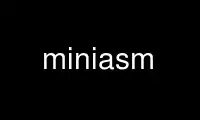
This is the command miniasm that can be run in the OnWorks free hosting provider using one of our multiple free online workstations such as Ubuntu Online, Fedora Online, Windows online emulator or MAC OS online emulator
PROGRAM:
NAME
miniasm - de novo assembler for long read sequences
SYNOPSIS
miniasm [-b12V] [-m minMatch] [-i minIden] [-s minSpan] [-c minCov] [-o minOvlp] [-h
maxHang] [-I intThres] [-g maxGapDiff] [-d maxBubDist] [-e minUtgSize] [-f readFile] [-n
nRounds] [-r dropRatio] [-F finalDropRatio] [-p outputInfo] mapping.paf > output.gfa
DESCRIPTION
Miniasm is a very fast OLC-based de novo assembler for noisy long reads. It takes all-vs-
all read self-mappings in the PAF format as input and outputs an assembly graph in the GFA
format. Different from mainstream assemblers, miniasm does not have a consensus step. It
simply concatenates pieces of read sequences to generate the final unitig sequences. Thus
the per-base error rate is similar to the raw input reads.
OPTIONS
Preselection options
-m INT Drop mappings having less than INT matching bases (col10 in PAF) [100]. This
option has the same role as -L of minimap.
-s INT Drop mappings shorter than INT-bp [1000]. This option also affects the second
round of read filtering and minimal overlap length.
-i FLOAT During read filtering, ignore mappings with col10/col11 below FLOAT [0.05].
Ignored mappings are still used for read overlaps.
-c INT Minimal coverage by other reads [3]. In the first round of filtering, miniasm
finds the longest region covered by INT or more reads. In the second round, it
in addition requires each remaining base to be covered by INT bases at least
minSpan/2 from the ends of other reads.
Overlapping options
-o INT Minimal overlap length [same as minSpan]
-h INT Maximum overhang length [1000]. An overhang is an unmapped region that should be
mapped given a true overlap or true containment. If the overhang is too long,
the mapping is considered an internal match and will be ignored.
-I FLOAT Minimal ratio of mapping length to mapping+overhang length for a mapping
considered a containment or an overlap [0.8]. This option has a similar role to
-h, except that it controls the ratio, not length.
Graph layout options
-g INT Maximal gap differences between two reads in a mapping [1000]. This parameter is
only used for transitive reduction.
-d INT Maximal probing distance for bubble popping [50000]. Bubbles longer than INT
will not be popped.
-e INT A unitig is considered small if it is composed of less than INT reads [4].
Miniasm may try to remove small unitigs at various steps.
-f FILE Read sequence file in FASTA or FASTQ format for generating unitig sequences
[null]. If this option is absent, miniasm produces a GFA output without
sequences.
-r FLOAT1,[FLOAT2]
Max and min overlap drop ratio [0.7,0.5]. Let overlap(v->w) be the overlap
length of edge v->w and maxovlp(v)=max_w{overlap(v->w)} be the length of largest
overlap. Miniasm drops overlap v->w if overlap(v->w)/maxovlp(v) is below a
threshold controled by this option. Miniasm applies nRounds rounds of short
overlap removal with an increasing threshold between FLOAT1 and FLOAT2.
-n INT Rounds of short overlap removal [3].
-F FLOAT Overlap drop ratio threshold after short unitig removal [0.8]
Miscellaneous options
-b Indicate that in the input, the same mapping is likely to be given twice
-1 Skip the first round of pre-assembly read selection
-2 Skip the second round of pre-assembly read selection
-p STR Output information and format [ug]. Possible STR values include - bed: post-
filtered read regions in the BED format; paf: mappings between post-filtered
reads; sg: read overlap graph in the GFA format; ug: unitig graph in the GFA
format.
-V Print version number to stdout
INPUT FORMAT
Miniasm reads mapping positions in the Pairwise mApping Format (PAF), which is a TAB-
delimited text format with each line consisting of at least 12 fields as are described in
the following table:
┌────┬────────┬─────────────────────────────────────────────────────────────┐
│Col │ Type │ Description │
├────┼────────┼─────────────────────────────────────────────────────────────┤
│ 1 │ string │ Query sequence name │
│ 2 │ int │ Query sequence length │
│ 3 │ int │ Query start coordinate (0-based) │
│ 4 │ int │ Query end coordinate (0-based) │
│ 5 │ char │ `+' if query and target on the same strand; `-' if opposite │
│ 6 │ string │ Target sequence name │
│ 7 │ int │ Target sequence length │
│ 8 │ int │ Target start coordinate on the original strand │
│ 9 │ int │ Target end coordinate on the original strand │
│ 10 │ int │ Number of matching bases in the mapping │
│ 11 │ int │ Number bases, including gaps, in the mapping │
│ 12 │ int │ Mapping quality (0-255 with 255 for missing) │
└────┴────────┴─────────────────────────────────────────────────────────────┘
Please see minimap(1) for the detailed description of each field.
OUTPUT FORMAT
Miniasm outputs the assembly in the Graphical Fragment Assembly format (GFA). It is a
line based TAB-delimited format, with the leading letter indicates the type of the line.
The following table gives the line types used by miniasm:
┌─────┬─────────────┬────────────────────────────────────────────────────┐
│Line │ Comment │ Fixed fields │
├─────┼─────────────┼────────────────────────────────────────────────────┤
│ H │ Header │ N/A │
│ S │ Segment │ segName segSeq │
│ L │ Overlap │ segName1 segOri1 segName2 segOri2 ovlpCIGAR │
│ a │ Golden path │ utgName utgStart readName:start-end readOri length │
└─────┴─────────────┴────────────────────────────────────────────────────┘
Use miniasm online using onworks.net services
